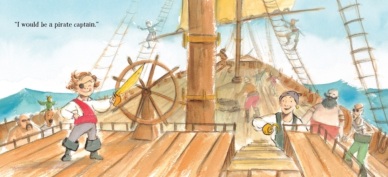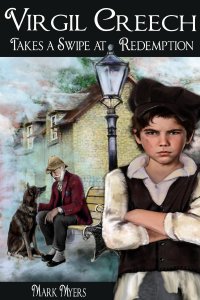Mother's Day will be here before you know it! Celebrate by entering to win a copy of You Made Me a Mother, written by Laurenne Sala and illustrated by Robin Preiss Glasser. Giveaway begins March 8, 2016, at 12:01 A.M. PST and ends April 8, 2016, at 11:59 P.M. PST.
Add a CommentViewing: Blog Posts Tagged with: Family Relationships, Most Recent at Top [Help]
Results 1 - 25 of 28
Blog: The Children's Book Review (Login to Add to MyJacketFlap)
JacketFlap tags: Mommy books, Laurenne Sala, HarperCollins, Giveaways, Mothers, featured, Family Relationships, Robin Preiss Glasser, Books for Mother's Day, Add a tag
Blog: The Children's Book Review (Login to Add to MyJacketFlap)
JacketFlap tags: Seasonal: Holiday Books, Mommy books, Laurenne Sala, HarperCollins, Writing Tips, Writing Resources, Ages 4-8, Picture Books, Mothers, featured, Character Development, Family Relationships, Art Of Writing, Robin Preiss Glasser, Tips For Writing, Books for Mother's Day, Add a tag
Laurenne Sala began her career as an advertising copywriter, writing national campaigns for clients like KIA Motors, Jack-in-the-Box, and Beats by Dre.
Add a CommentBlog: Kid Lit Reviews (Login to Add to MyJacketFlap)
JacketFlap tags: Children's Books, Picture Books, family relationships, novelty book, shower gifts, Capstone Young Readers, Benjamin Bird, 5-Stars, A Baby’s Guide to Surviving Dad, Baby Survival Guides, Tiago Americo, Add a tag
A Baby’s Guide to Surviving Dad Series: Baby Survival Guides Written by Benjamin Bird Illustrated by Tiago Americo Capstone Young Readers 2/01/2016 978-1-62370-610-4 24 pages 6″ X 7″ Ages 0—3 . “HELLO, BABY. “The whole life thing is pretty new to you, right? Luckily, you have a dad. Unluckily, he’s new to the …![]()
Blog: Miss Marple's Musings (Login to Add to MyJacketFlap)
JacketFlap tags: romantic relationships, Diversity Reading Challenge 2015, TRAFFICK, sex trafficking of minors, transphobia, 2015 Diversity Reading Challenge, YA, minors, homosexuality, Book recommendation, Tricks, abuse, Las Vegas, Ellen Hopkins, family relationships, homophobia, Add a tag
Title: Traffick (sequel to TRICKS) Author: Ellen Hopkins Publisher: Margaret K. McElderry Books, November, 2015 Themes: sex trafficking of minors, tricks, homosexuality, homophobia, transphobia, family relationships, romantic relationships, abuse, Las Vegas Genre: Contemporary YA Ages: 14+ Opening: A Poem By Cody Bennet Can’t Find The courage to leap the brink, free-fall beyond the … Continue reading
Add a CommentBlog: Kid Lit Reviews (Login to Add to MyJacketFlap)
JacketFlap tags: Children's Books, Picture Book, humor, Favorites, Diane Goode, Chronicle Books, Karate, Ninja, Kung Fu, sibling rivalry, family relationships, new sibling, Library Donated Books, 6 Stars TOP BOOK, David Zeltser, Top 10 of 2015, Ninja Baby, Add a tag
Ninja Baby Written by David Zeltser Illustrated by Diane Goode . . .Chronicle Books 11/01/2015 . . 978-1-4521-3542-7 . . 32 …![]()
Blog: Perpetually Adolescent (Login to Add to MyJacketFlap)
JacketFlap tags: Letter Writing, Father's Day, Stephen Michael King, family relationships, New Book Releases, Scholastic Australia, Dimity Powell, Book Reviews - Childrens and Young Adult, Simon Williams, Ed Allen, Dear Dad I Want to be Just Like You, My Dad is a Giraffe, Add a tag
My Dad is a Giraffe Dads are often described as bears and can be boorish but does yours remind you of a giraffe? If he’s tall and gentle, fast and spotty and good to climb up, chances are he is a giraffe. My Dad is a Giraffe is the latest technicoloured picture book by genius, […]
Add a CommentBlog: The Children's Book Review (Login to Add to MyJacketFlap)
JacketFlap tags: Health, Mental Health, Humor, Chapter Books, Books for Girls, Sophie Kinsella, Family Relationships, Humorous Books, Teens: Young Adults, Contemporary Romance Books, Family Conflicts, Add a tag
Sophie Kinsella is the bestselling author of The Shopaholic Series. Her hilarious style of writing will entrance readers of any age.
Add a CommentBlog: The Children's Book Review (Login to Add to MyJacketFlap)
JacketFlap tags: Books for Girls, Family Relationships, Jessica Warman, Teens: Young Adults, Bloomsbury USA Books, Books with Kidnappings, Mysteries, Young Adult Fiction, Mystery, Chapter Books, Add a tag
Emotionally wrought and sharply written, The Last Good Day of the Year explores and examines the capacity of evil and the result is a fine, smart read that isn’t afraid to uncover the frailty and weight of guilt and family relationships.
Add a CommentBlog: Perpetually Adolescent (Login to Add to MyJacketFlap)
JacketFlap tags: Book News, memories, grandparents, newspapers, asthma, Alzheimer's disease, growing older, family relationships, Wombat Books, owen swan, Dimity Powell, Book Reviews - Childrens and Young Adult, Leigh Hedstrom, Phil Cummings, Katrina Roe, Emily Eases her Wheezes, historical moments, Newspaper Hats, Sholastic Press, Add a tag
When medical conditions affect children or the people in their lives, one of the most daunting aspects of their situation is how to cope. The management of a disease or disability is one thing, the understanding why they have it and why others react the way they do is another. Picture books are marvellous non-invasive […]
Add a CommentBlog: Kid Lit Reviews (Login to Add to MyJacketFlap)
JacketFlap tags: Middle Grade, humor, Favorites, New York City, Series, twins, Books for Boys, private schools, Little, family relationships, Brown and Company, 5stars, Geoff Rodkey, Chronicle of Egg, Hachette Book Grou, sibling fighting, The Trapper Twins Go to War (with each other), The Trapper Twins Tear Up New York, Add a tag
 The Tapper Twins Go to War (with Each Other)
The Tapper Twins Go to War (with Each Other)
written by Claudia Tapper with Geoff Rodkey
Little, Brown and Company 4/07/2015
978-0-316-29779-0
236 pages Age 8—12
“This brand-new series by a popular screenwriter is a pitch-perfect, contemporary comedy featuring twelve-year-old fraternal twins, Claudia and Reese, who couldn’t be more different…except in their determination to come out on top in a vicious prank war! But when the competition escalates into an all-out battle that’s fought from the cafeteria of their New York City private school all the way to the fictional universe of an online video game, the twins have to decide if their efforts to destroy each other are worth the price.
“Told as a colorful “oral history” by the twins and their friends, and including photos, screenshots, chat logs, online gaming digital art, and text messages between their clueless parents, The Tapper Twins is a hilariously authentic showcase of what it’s like to be in middle school in our digitally-saturated world.” [publisher]
Review
Claudia and Reese, age 12, twins, are at war, with each other. Who started the war depends on whom you ask, Claudia or Reese. They cannot agree on anything. Claudia decides, after the war is over, to document what happened. She writes using all at her disposal, including photos, interviews, online screenshots, and her mostly-absent parents’ phone text messages. I love her description of her and Reese,
“We are, unfortunately, twins. I am twelve years old. Reese is six.”
Reese interjects whenever he can. Like any war, it starts when one side (Reese), accuses the other side (Claudia), of doing something wrong (farting in the sixth-grade cafeteria), which harms others (a few sixth-grade princess sensibilities, many noses, and Jens—Claudia’s secret crush). Embarrassed and angry at such a terrible accusation—she claims innocence—Claudia is out for revenge. The War has begun.
Claudia tries several ways of embarrassing her brother, but Reese does not embarrass easily. Claudia begins by placing a large, dead, stinky fish in Reese’s backpack, but even after several days, and others complaining of the awful smell, Reese doesn’t notice. When he learns of the fish, he fires back. Then Claudia returns his fire, and back-and-forth, until someone is tragically hurt. The fighting is both online and off for some digital-age humor. Claudia also allows others to comment in her “Officially True History of the War between the Trapper Twins (Claudia and Reese).” These interjections into Claudia’s history of war help the story gel into a humorous middle school tale. Readers meet Claudia’s secret Norwegian crush (Jens), the twins’ Upper East Side private school friends, the snobby Princesses, and the twin’s parents.
Rodkey, who wrote the excellent Chronicles of Egg series (reviewed here: bk1, bk2, bk3), knows his readers well and understands how siblings fight. I loved the first book of this new series, which delves into cyberbullying as part of the twins’ fighting. Even though Claudia writes the history, she comes off as the antagonist, rather than the victim she sees herself to be, making it easy to favor Reese. Still, the sibling fighting feels natural, not forced. That the twins are more alike than they believe and never really lose their sibling-love is also true to form. If you have siblings, you just might recognize yourself in either Claudia or Reese.
The Trapper Twins will have readers laughing, happily rolling their eyes, and smiling throughout its witty story. Those who like the Dork series, or the Aldo Zelnick Alphabet Novels (example here), will love The Trapper Twins even more. The Trapper Twins series continues this September with book 2: The Trapper Twins Tear Up New York. The prologue and first chapter are at the back of this book to give you a taste of the next. I cannot wait to continue this series. I love Rodkey’s writing and his wit.
THE TRAPPER TWINS GO TO WAR (WITH EACH OTHER). Text copyright © 2015 by Geoff Rodkey. Illustrations and photographs (except where noted) copyright © 2015 by Geoff Rodkey. Reproduced by permission of the publisher, Little, Brown and Company, New York, NY.
Purchase The Trapper Twins Go to War at Amazon—Book Depository—iTunes— Hachette Book Group.
The Trapper Twins made the New York Times Bestseller List at #14!
Learn more about The Trapper Twins Go to War (with each other) HERE.
Read an Excerpt HERE.
Meet the author, Geoff Rodkey, at his website: http://geoffrodkey.com/
Meet the illustrator, The Trapper Twins book website: http://www.tappertwins.com/
Find more middle grade books at the Little, Brown and Company website: http://www.hachettebookgroup.com/kids/
Little, Brown and Company is part of the Hachette Book Group
Copyright © 2015 by Sue Morris/Kid Lit Reviews. All Rights Reserved
Review section word count = 413
Filed under: 5stars, Books for Boys, Favorites, Middle Grade, Series Tagged: Brown and Company, Chronicle of Egg, family relationships, Geoff Rodkey, Hachette Book Grou, humor, Little, New York City, private schools, sibling fighting, The Trapper Twins Go to War (with each other), The Trapper Twins Tear Up New York, twins
Blog: The Children's Book Review (Login to Add to MyJacketFlap)
JacketFlap tags: Conflict, Ages 9-12, Sports, Baseball, Middle School, Humor, Chapter Books, Books for Boys, Family Relationships, Humorous Books, Audrey Vernick, HMH Books for Young Readers, Books About Umpires, Journalism Books, Add a tag
Screaming at the Ump will appeal to both boys and girls who are interested in sports (especially baseball), and journalism, coping with the transition to middle school, or dealing with family conflicts.
Add a CommentBlog: Kid Lit Reviews (Login to Add to MyJacketFlap)
JacketFlap tags: family relationships, daddy books, Library Donated Books, 6 Stars TOP BOOK, Druthers, Top 10 of 2015, great Father's Day gift, Matt Pheln, Children's Books, creativity, Picture Book, imagination, Favorites, Candlewick Press, Add a tag
Written & Illustrated by Matt Phelan
Candlestick Press 9/09/2014
978-0-7636-5955-4 
32 pages Age 2—5
x
x
“It’s raining and raining and raining, and Penelope is bored. “What would you do if you had your druthers?” asks her daddy. Well, if Penelope had her druthers, she’d go to the zoo. Or be a cowgirl. Or a pirate captain who sails to the island of dinosaurs, or flies away on a rocket to the moon. If Penelope had her druthers, she’d go off on amazing adventures — but then again, being stuck inside may not be so bad if your daddy is along for the ride!” [publisher]
Review
It’s a rainy day and young Ms. Penelope is bored. Rain continues flowing down the window and the sky remains dark. Dad is home reading a book—good for you dad—and he notices his daughter’s frustration and boredom. Dad asks Penelope,
“If you had your druthers, what would you do?”
“What are druthers?”
“Druthers are what you would rather do if you could do anything at all.”
Penelope decides if she had her druthers, she and dad would go to the zoo. That is just what they do. Hunkered down behind the bars of a stair railing, dad becomes a caged ape. “Ooo-ooo-ooo,” Dad calls out from his “cage.”
But druthers change and Penelope decides she would like to be a cowgirl. Dad strides one arm of the couch and his daughter the other. Together they ride their horses . . . until Penelope decides being a pirate would be fun . . . and flying to the moon . . . and . . . with dad tuckered out Penelope makes one final druthers.
“But I guess if I really had my druthers . . . “
Druthers is a wonderful book for rainy days or any boring day. It exemplifies the creativity of imagination. Dad is a hoot and the perfect parent to spend a day with, on any day. I also love that while Penelope is staring out the window waiting for the rain to stop, Dad is reading a book. What a wonderful detail to promote reading. I also love all the activities the two imagined while laughing, singing, dancing, smiling, and enjoying each other while playing together like best friends.
The illustrations are wonderful and do a great job of visualizing all of Penelope’s druthers. Kids and parents will love the story and each scenario and, like myself, all the details that make everything come alive. Druthers allows you to experience the fun, and laugh along with Dad and Penelope. There are not enough books with dad directly involved with his child. Druthers is the best “Dad book”and a wonderful gift idea for Father’s Day (tie not included).
Penelope’s really druthers,
“. . . it would rain tomorrow, too.”
Druthers is a keeper! If I had my druthers, every dad would share this book with his child(ren), boy or girl.
DRUTHERS. Text and illustrations © 2014 by Matt Phelan. Reproduced by permission of the publisher, Candlewick Press, Sommerville, MA.
X
Purchase Druthers at Amazon—Book Depository—Candlewick Press.
Learn more about Druthers HERE.
Meet the author/illustrator, Matt Phelan, at his website: http://www.mattphelan.com/studio-tour.html
Find more picture books at the Candlewick Press website: http://www.candlewick.com
Full Disclosure: Druthers, by Matt Phelan, and received from Candlewick Press, is in exchange NOT for a positive review, but for an HONEST review The opinions expressed belong to Kid Lit Reviews, and no one else. This is disclosed in accordance with The Federal Trade Commission 16CFR, Part 255: Guidelines Concerning the Use of Endorsements and Testimonials in Advertising.
Copyright © 2015 by Sue Morris/Kid Lit Reviews
Filed under: 6 Stars TOP BOOK, Children's Books, Favorites, Library Donated Books, Picture Book, Top 10 of 2015 Tagged: Candlewick Press, creativity, daddy books, Druthers, family relationships, great Father's Day gift, imagination, Matt Pheln
Blog: The Children's Book Review (Login to Add to MyJacketFlap)
JacketFlap tags: Ages 9-12, Diversity, Historical Fiction, Black History Month, Civil Rights, African American Authors, African American, featured, Books for Boys, Atheneum Books for Young Readers, Great Depression, Books for Girls, Adversity, Simon & Schuster Books for Young Readers, Segregation, Family Relationships, Sharon M. Draper, African American History Month, Ku Klux Klan, Cultural Wisdom, Books Set in the 1930s, Community Relationships, Add a tag
Stella by Starlight, by esteemed storyteller Sharon M. Draper, is a poignant novel that beautifully captures the depth and complexities within individuals, a community, and society in 1932, an era when segregation and poverty is at the forefront.
Add a CommentBlog: The Children's Book Review (Login to Add to MyJacketFlap)
JacketFlap tags: Health, Ages 9-12, Birds, Nature, Chapter Books, Suicide, Depression, Wendy Lamb Books, Multiple Sclerosis, Friendships, Nest, Random House Children's Books, Family Relationships, Environment & Ecology, Social Graces, Esther Ehrlich, Cape Cod Books, Orinthology, Add a tag
Esther Ehrlich’s debut novel, Nest, is an arresting story of an eleven-year-old girl named Chirp Orenstein, whose life becomes acutely sharp and complicated as her mother’s illness overtakes the family
Add a CommentBlog: The Children's Book Review (Login to Add to MyJacketFlap)
JacketFlap tags: Ages 9-12, Science, Humor, Chapter Books, Jennifer L. Holm, Scientists, Books for Girls, Random House Books for Young Readers, Marie Curie, STEM, Family Relationships, Immortality, Jonas Salk, Robert Oppenheimer, Middle Grade Read Aloud Books, Add a tag
The Fourteenth Goldfish is a clever novel that offers depth with humor while intersecting science and childhood in a memorable story perfect for sharing aloud with boys or girls.
Add a CommentBlog: (Login to Add to MyJacketFlap)
JacketFlap tags: Young Adult, Young Adult Fiction, featured, school life, Canadian author, family relationships, Add a tag
Anywhere but Here – written by Tanya Lloyd Kyi | Storytime Standouts
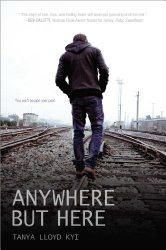 Anywhere But Here written by Tanya Lloyd Kyi
Anywhere But Here written by Tanya Lloyd Kyi
Young Adult Fiction published by Simon and Schuster
I feel compelled to share some aspects of my personal life before I write about Anywhere but Here. I was attending university and living with my folks when my mom died four days prior to surgery that had been scheduled to repair a heart valve. It was shocking and devastating and, without a doubt, the most difficult experience of my life.
Weeks later, my dad began dating. When I say ‘weeks,’ I mean less than three months later. While still grieving the sudden loss of my mom and feeling as though my life had been turned upside down, I was watching as my dad began a relationship with a woman he would eventually marry. Dad’s second marriage was an enduring one. To be honest, I am not sure which of his marriages was longer: he celebrated twenty-fifth wedding anniversaries twice.
Anywhere but Here is the story of a young man, still in high school, who is coping with the loss of his mom. Cole finds life in a small town stifling. He is eager to finish high school and make a break from his acquaintances, friends and family. He has ended a two year relationship with a girlfriend and finds her behavior and that of some classmates confusing. His family life is in ruins. Cole’s dad drinks heavily and meets an exotic dancer. Before long, she is pregnant and Cole’s dad explains that she will be moving into the family home along with her young daughter.
With the encouragement of a school guidance counselor, Cole considers enrolling in a post secondary cinematography program. As part of his application, his must create a short film. It is while filming that Cole examines his community and gains perspective.
Beautifully written, Anywhere but Here accurately depicts the turmoil and confusion that occur when one parent dies and the surviving parent enters into a new relationship – especially when the surviving child(ren) are young adults. I especially liked the authenticity of Cole’s voice and the relationships between Cole and his guidance counselor, his mom’s former nurse and his classmates. This is a novel that begs for a sequel and I very much look forward to reading it.
Anywhere But Here at Amazon.com
Anywhere But Here at Amazon.ca
Storytime Standouts - Raising Children Who Love to Read
Add a CommentBlog: Kid Lit Reviews (Login to Add to MyJacketFlap)
JacketFlap tags: humor, Series, Reluctant Readers, children's book reviews, pranks, family relationships, 4stars, jinxed, Library Donated Books, Jespar Jinx, Marko Kitti, reluctant reaers, Spanish teacher, Children's Books, Chapter Book, Add a tag
 x
x
x
by Marko Kitti
published by Marko Kitti 4/28/2014
978-1-4974-5822-2
Age 7 to 9 152 pages
x
“Jesper Jinx is eleven, and probably the unluckiest person in all of Puffington Hill. Everything he touches seems to end up in sweet disaster. Hence his nickname “Jinx.” In this first book of Jesper Jinx’s wonderfully wicked adventures you’re going to meet Jesper’s family and Snowy the Cat. Also, there’s a mysterious new classmate with a moustache. And it‘s up to Jesper to launch his famous Boredom Breaker. What harm would it do to have a little fun?”
Opening
“Jesper Jinx watched as his older sister Melinda popped her soda an open and took a small sip from it.”
The Story
Jesper Jinx loves his pranks but the pranks have earned him a nickname. Even some of his best pranks are jinxed, like the time he switched his sister’s beloved energy drink, Guaraná Antarctica, with a horrible homemade concoction. She deserved it. She snooped at his diary. At dinner, dad took a swing of Melinda’s “energy drink” and about gagged, no, wait, he did gag and so did Melinda. She was well worth it, but not dad. Jesper ran out of the house before anyone could accuse him and ran into the author of this book. Sworn to secrecy, the author agreed to write a book only Jesper’s eyes would see. This is that book.

Two short stories are included in book 1: Jesper Jinx and the Colourful Cat and Jesper Jinx and the Spanish Shenanigans. For animal lovers, the first story will amuse you, especially if you are owned by a dog. Jesper accidentally causes Snowy, the cat, to turn several shades of red moments before his mother is to show her off to a disliked neighbor. To make matters worse, the cat, named for its pure white coat of fur, disappears, like magic. One minute, she was under a towel and the next, gone. Of course, this is when the dreaded neighbor rings the doorbell. Is it really magic? Is Snowy a magical cat? Mom believes so, if only for a short minute. Then she realizes Jesper is involved and has him bathe Snowy. Everyone knows cats do not like bathes. Jinxed!  With claws!
With claws!
In the Spanish Shenanigans, it is not Jesper pulling the shenanigans. There is a new kid in class, and he has a moustache on his upper lip. His name is José Maria, and he has a moustache, a real one, and a deep voice. José claims everything grows faster in the hot Spanish sun, but Jasper is not inclined to believe him, well, he is inclined enough to show José all of his best pranks. School will not be the same for Jesper and his best friend Oliver. Their teacher, Miss Parrot, who likes to repeat what she hears, has a life-changing experience and leaves school—for good. Jesper and Oliver will get a new teacher. A short-for-his-age teacher who has a deep voice (girls will swoon over), and a real moustache on his upper lip. The new teacher now knows all of Jesper and Oliver’s favorite pranks. Jinxed!
Review
I read Jesper Jinx in one sitting and enjoyed the crazy antics of both Jesper and the author. The author begins by explaining how he came to Puffington Hill, home of Jesper, and how he acquired Jesper’s stories— and the secrecy by which he swore to handle his stories. There is even a certificate of secrecy readers must sign. Running out of the house after dad takes a swing of Melinda’s tampered Guaraná Antarctica energy drink, Jesper runs into the vacationing author. Then  the stories begin. Oh, yes, Jesper Jinx is Finnish author, Marco Kitti’s first English language chapter book.
the stories begin. Oh, yes, Jesper Jinx is Finnish author, Marco Kitti’s first English language chapter book.
I like the story of the red Snowy cat and its disappearance from under the towel. The cat’s portrayal is realistic. I cannot count the number of times my cat is not where he was only moments before and then suddenly shows up where he could not possibly be at. The behavior is enough to drive a person to dogs. The humor is well timed and Jesper’s reactions are convincing. I love that mom is going to show off a cat she otherwise wants nothing to do with. Snowy belongs to Jesper when the litter box needs cleaned or the cat is in mom’s space. But bring the snooty neighbor comes around Snowy becomes mom’s treasure. I like how the author includes bits of life that are true for many readers. Like dad, engrossed in his newspaper, only coming up for air when he wants something, but don’t try to talk to him.
In the shenanigans story, it is confusing why this new kid is suddenly in class and why the teacher swooned whenever she said his name. The teacher is wacky, repeating what the student said, before answering.
“Yes, Jesper?” said Miss Parrot. “Do you have something to share with us all?”
“No,” said Jesper.
“No,” said Miss Parrot. “Is there something . . . ?”
“No, Miss Parrot,” said Jesper.
“No, Miss Parrot,” repeated Miss Parrot. “Then how about you, Oliver?”
“I can’t think of any questions, Miss Parrot,” said Oliver.
“Think of any questions, Miss Parrot!” said the teacher.
Yes, it can get tiring, but then Miss Parrot quickly disappears. She is busy driving her souped-up Mercedes. The story is about José Maria, Jesper, and Oliver’s budding friendship. It is odd that José has a moustache but then, I can remember certain boys tended to get their hairy lip early. So, I believed this. The deep voice at eleven I also believed. Maybe he is older and flunked a few grades. You must believe or the story cannot go on. Poor Jesper, he is jinxed the moment the man-boy walks into his classroom. Trying to be a nice kid, Jesper and his friend Oliver befriend José. José asks Jesper about pranks, so Jesper shows him the best pranks he an Oliver pull on teachers.

Jesper is a likable character, kids age 7 and up will enjoy, along with all of his the crazy stories. The stories are short, and the vocabulary basic, so a reluctant reader can enjoy Jesper’s antics. Jesper Jinx will entertain both boys and girls who like crazy plot twists you don’t expect. The antics are similar to those in the the Aldo Zelnick alphabet book series.(Reviewed here: “J” “K”) Just remember one important detail, you must keep the contents of these books a secret. Jesper believes the author is only printing one copy for himself only. If he finds out that is not true, he will stop telling the author his stories. Jesper Jinx is a welcome addition to chapter books and books for reluctant readers.
JESPER JINX. Text and illustrations copyright © 2014 by Marko Kitti. Reproduced by permission of the publisher, Marko Kitti,
Purchase Jasper Jinx at Amazon—B&N—Book Depository—CreateSpace—Marko Kitti—your favorite bookstore.
Check out what a local Gargoyle had to say about Jesper Jinx right HERE.
Learn more about Jasper Jinx HERE.
Meet the author / illustrator, Marko Kitti, at his website: http://www.markokitti.net/en.html
x
x

x
x
copyright © 2014 by Sue Morris/Kid Lit Reviews
Filed under: 4stars, Chapter Book, Children's Books, Library Donated Books, Reluctant Readers, Series Tagged: Chapter book, children's book reviews, family relationships, humor, Jespar Jinx, jinxed, Marko Kitti, pranks, reluctant reaers, Spanish teacher
Blog: Kid Lit Reviews (Login to Add to MyJacketFlap)
JacketFlap tags: friends, Middle Grade, Favorites, Series, children's book reviews, Books for Boys, middle grade novel, Debut Author, bullies, family relationships, 1920's, 5stars, boy's book, Library Donated Books, Mark Myers, Virgil Creech Takes a Swipe at Redemption, Add a tag
Virgil Creech Takes a Swipe at Redemption
written by Mark Myers
published by Mark Myers 12/19/2013
978-0-61587615-3
Age 8 to 13 222 pages
.
“Welcome to the sleepy little town of Portsong, Georgia where there is a struggle a foot. Unbeknownst to the current owner, Virgil Creech has his selfish eyes set on taking back a dog he considers his. To be fair, as the youngest of nine bickering and bustling brothers, Virgil has always had to fight for the few things he could call his own. In this case, the property in question ran away from Virgil several months prior and now wants nothing to do with the boy, for he has found a happy home with the kindly Colonel Clarence Birdwhistle. Undetered, Virgil teams up with reluctant friend, Henry Lee, to retrieve the dog.”
Opening
“That was a mark!” yelled Henry as he disappeared behind the row of elm trees to round up the ball.”
The Story
Four friends, Virgil, Henry, Willy, and Joe are playing in the town green (like a park) when Virgil kicks the ball hard and too high hitting Colonel Birdwhistle in the back of the head, knocking him out onto the pavement. The boys cautiously check to see if he is alive and Virgil accidentally causes Birdwhistle to hit his head again, knocking him cold. Later, at the hospital, Willy and Joe check on Birdwhistle and leave believing the boys have caused Birdwhistle to become blind. Willy, Joe, and Henry decide to find a dog, train it as a Seeing Eye dog, and give him to the Colonel.
At the city dump, the boys find a dirty, matted, and awful smelling mongrel. Henry gives the dog a half-hour session in leading the blind, and then takes the dog to the hospital, leaving it in Birdwhistle’s room. The Colonel takes the mutt home, cleans him up, and decides to keep him. The dog, now named Oscar, is now a happy dog.
Virgil realizes Oscar his is dog and is mad that Birdwhistle stole the dog from him. According to Virgil, Birdwhistle came right into his house and took Bertie (same dog, different name). Virgil is determined to get his dog back and enlists the help of his one friend, Henry Lee. Henry is determined to keep Virgil sway from Oscar. To complicate matters, a nationwide contest for a trip to Africa gets the town, including Virgil, up in a tizzy. Virgil knows he is the winner and must just wait for the day his name is called. When he returns from Africa, he will then get his dog back. But Colonel Birdwhistle has been entered hundreds of times by townsfolk who appreciate and admire him. Birdwhistle wins, causing Virgil to believe the Colonel has now stolen two things from him. He is madder than two Creech boys fighting over a chicken drumstick are. How will Henry contain Virgil and keep Oscar safe and with Birdwhistle. Can he do it?
Review
Virgil Creech Takes a Swipe at Redemption tells the story of two boys, Virgil, Henry, a British transplant, and the man’s dog, Oscar. Virgil is a mean boy, the last of nine boys. Not a day goes by that he is not beat or taken advantage by one of his brothers. In turn, Virgil always has a chip on his shoulder, beats up kids at school, must always get his way, and has no friends. Virgil’s temper is as short as a temper can possibly be. Henry is a kind, well-mannered boy from a fine family. After Virgil kicks a ball that knocks-out Colonel Birdwhistle, the boys, especially Henry and Virgil, are thrown together for survival.
The well-planned and well-written story will keep you turning the pages. The author understands the psyche of the twelve-year-old boy and offers explanations and comments throughout the book. At first, I thought these annoying, but as more and more pages turned, the narrative became more natural, the comments regarding boys in general became interesting, and the story became a smooth ride, except for the Virgil bumps along the way. Packed with humor, tender moments, and upheaval only two young boys can cause, Virgil Creech Takes a Swipe at Redemption will please adults as well as kids.
I enjoyed the story, which focused more on Henry and his life than on the main character, Virgil. As one reviewer has already pointed out, Henry should be the protagonist. Virgil is a perfect antagonist and causes most of Henry’s stress. Once Henry understands how Virgil treated his dog and how the dog ended up living in the city dump, he vows to keep Oscar with the Colonel. Even Oscar stays away from Virgil, refusing to go anywhere he can smell the boy—which is not hard for anyone to do. At one point, the author states that Virgil is the only Creech that did a selfless act. Not so, the two brothers who rescued Bertie (Oscar in a former life), and cared for the dog, albeit in a dump, thought only of the dog, not themselves. Seems any Creech could have a heart deep within his chest.
There are no illustrations in the story. Oscar is a small dog, one that Henry can easily pick up. The dog on the cover is not small. I do like the angry hate-the-world scowl on Virgil’s face. This accurately portrays the boy’s disposition. While reading the story, Colonel Birdwhistle looked very near the image on the cover. The houses seem out of place for an area of town filled with green grass. Maybe on the other side they would be correct. Having saidall that, for someone who has not read the story, the cover is inviting and makes you want to know what the scamp on the cover has done.
I am not overly fond of the trick Birdwhistle and George, Henry’s father, plays on the town when Birdwhistle decides not to accept the trip he won, without entering himself. I like the first part, but what is the difference, as Henry asks, between leaving for three months and hiding out, without your dog, for three months. The Colonel does not want to leave the town, where he feels accepted and a member of nearly every family, yet he is still gone from the children and the story hour Birdwhistle did not want to miss. It would have made more sense for the Colonel to feign an illness. The author wanted a twist that would delight the reader but I think this failed to hit the mark.
Kids who love adventure or family-spun stories will enjoy Virgil Creech Takes a Swipe at Redemption. For his first book, Myers offered readers a well-crafted story, less the twist. There is a second Virgil Creech story to be released this Fall. I cannot wait to find out what bothers Virgil enough to make his face “glow red.” It is entitled, Virgil Creech Sings for His Supper. There is no preview, so make of this title as you will. Just the idea of Virgil singing scares me.
For a middle grade boy’s perspective of Virgil Creech Takes a Swipe at Redemption click HERE.
VIRGIL CREECH TAKES A SWIPE AT REDEMPTION. Text copyright © 2013 by Mark Myers.
To purchase your copy of Virgil Creech Takes a Swipe at Redemption go to Amazon—B&N—Book Depository—Author’s Website—your favorite bookstore.
Learn more about Virgil Creech Takes a Swipe at Redemption HERE.
Meet the author, Mark Myers, at his website: https://portsong.wordpress.com/
.
.

m
m
copyright © 2014 by Sue Morris/Kid Lit Reviews
m
 m
m
Don’t forget! Evil Fairies Love Hair releases AUGUST 5th. As a reminder, the review is HERE.
Get it at Amazon B&N Book Depository Clarion
Filed under: 5stars, Books for Boys, Debut Author, Favorites, Library Donated Books, Middle Grade, Series Tagged: 1920's, boy's book, bullies, children's book reviews, family relationships, friends, Mark Myers, middle grade novel, Virgil Creech Takes a Swipe at Redemption
Blog: The Children's Book Review (Login to Add to MyJacketFlap)
JacketFlap tags: Ages 9-12, Health, Humor, Chapter Books, Chronicle Books, featured, Sisters, Multiple Sclerosis, Books for Girls, Family Relationships, Social Graces, Megan Jean Sovern, Add a tag
Readers will instantly fall in love with Maggie. Her narrative voice is smart, funny and clever, which makes her a highly entertaining, endearing, complex, triple threat.
Add a CommentBlog: Perpetually Adolescent (Login to Add to MyJacketFlap)
JacketFlap tags: verse novel, Glenda Millard, new book release, family relationships, Walker Books Australia, New Book Releases, Dimity Powell, Book Reviews - Childrens and Young Adult, Player Profiles, Book Reviews - Poetry, Gabriel Evans, Roses are Blue, blog tour, Sally Murphy, Add a tag
 I promised myself I wouldn’t cry. Well, maybe a few tears towards the end might be acceptable, but of course, I was dealing with another verse novel by Sally Murphy, so dry eyes were definitely no guarantee.
I promised myself I wouldn’t cry. Well, maybe a few tears towards the end might be acceptable, but of course, I was dealing with another verse novel by Sally Murphy, so dry eyes were definitely no guarantee.
 It’s not just the subject matter of Roses are Blue that tugs at ones heartstrings. Murphy is simply master at massaging sensitive issues into refined, understated yet terrifically moving poetic verse. Her words whisper across the pages with the soft intensity of a mountain breeze. They are beautiful and arresting; a joy to read.
It’s not just the subject matter of Roses are Blue that tugs at ones heartstrings. Murphy is simply master at massaging sensitive issues into refined, understated yet terrifically moving poetic verse. Her words whisper across the pages with the soft intensity of a mountain breeze. They are beautiful and arresting; a joy to read.
There are no chapters in this novel. The story ebbs and flows organically in a pleasing natural rhythm. Gabriel Evans’ tender ink and painted illustrations cushion the gravity of the story even more allowing the reader to connect with Amber and her world visually as well as emotionally. Youngsters cultivating their reading confidence will appreciate this generous visual reinforcement on nearly every page.
Amber Rose’s world is turned upside down when tragedy strikes her family leaving her mother devastatingly ‘different’. Overnight, everything is altered: there’s a new school, new friends, new home, new secrets and perhaps hardest of all, a new mum to get used to. Amber vacillates between wanting to fit in and appear normal, aching for how things ‘used to be’ and trying to reconnect with her damaged mum.
As Amber’s mother struggles to free herself from her new entrapment, so too does Amber fight to hang onto to their special shared love until, like springtime roses, hope eventually blooms. Roses are Blue addresses the complex issues of normality, family ties, friendships and maternal bonds with gentle emphasis on how all these relationships can span any ethnicity or physical situation.
To celebrate Amber’s story, Sally Murphy joins me at the draft table with a box of tissues and a few more fascinating insights on Roses are Blue. Welcome Sally!
Q. Who is Sally Murphy? Please describe your writerly self.
My writely self? I try hard to think of myself as writerly – but often fail miserably because I think of other writers as amazingly productive, clever , creative people, and myself as someone slightly manic who manages to snatch time to write and is always surprised when it’s good enough to get published.
But seriously, I suppose what I am is someone who writes because it’s my passion and I can’t not do it. I’ve been writing all my life, pretty much always for children, and my first book was published about 18 years ago. Since then I’ve written picture books, chapter books, reading books, educational resource books and, of course, poetry and verse novels.
Q. I find verse novels profoundly powerful. How different are they to write compared to writing in prose? Do you find them more or less difficult to develop?
I think they’re very powerful too. It was the power of the first ones I read (by Margaret Wild) that made me fall in love with the form. But it’s this very power that can make them hard to get right – you have to tap into core emotions and get them on the page whilst still developing a story arc, characters, setting, dialogue and so on.
Are they more or less difficult? I’m not sure. For me I’ve been more successful with verse novels than with prose novels, so maybe they’re easier for me. But it is difficult to write a verse novel that a publisher will publish – because they can be difficult to sell.
Q. How do you think verse novels enhance the appeal and impact of a story for younger readers?
I think they work wonderfully with young readers for a few reasons, which makes them a wonderful classroom tool. The fact that they are poetry gives them white space and also, room for illustration and even sometimes text adornments.
What this means is that for a struggling reader or even a reluctant reader, the verse novel can draw them in because it looks easier, and gives them cues as to where to pause when reading, where the emphasis might be and so on. They will also feel that a verse novel is less challenging because it is shorter – there are less words on the same number of pages because of that white space.
But the verse novel can also attract more advanced readers who recognise it as poetry and thus expect to be challenged, and who can also see the layers of meaning, the poetic techniques and so on. Of course, once they’ve started reading it, the reluctant and struggling reader will also see those things, meaning there is a wonderful opportunity for all the class to feel involved and connected when it’s a class novel, or for peers of different abilities to appreciate a book they share.
 Q. Judging by some of your previous verse titles, Pearl Verses the World and Toppling, you are not afraid to tackle the heftier and occasionally heartbreaking issues children encounter. What compels you to write about these topics and why do so in verse? Do you think a verse novel can convey emotion more convincingly than prose alone?
Q. Judging by some of your previous verse titles, Pearl Verses the World and Toppling, you are not afraid to tackle the heftier and occasionally heartbreaking issues children encounter. What compels you to write about these topics and why do so in verse? Do you think a verse novel can convey emotion more convincingly than prose alone?
Afraid? Hah – I laugh in the face of danger! (Sorry, couldn’t help myself). But seriously no, I’m not afraid, because I think these are issues kids want to read about. All kids experience tough times – sometimes it’s the loss of a loved one, or illness, or a tragedy like Mum being sick/injured/absent. Other times it’s a beloved pet dying, or a best friend who suddenly doesn’t want to be friends. Either way, these tough times can feel like the end of the world. I think when children read about tough topics they connect with empathy or sympathy, and thus have the opportunity to experience vicariously something which they may not have. And if they have been through those really tragic tough times, or they do in the future, I hope they’re getting the message that life can be tough but you can get through it. Terrible things happen in the world – but good things do too. It’s really important to me that my stories have happy times too, and even laughs.
For me the verse novel form enables me to convey that emotion, but I don’t think it’s the only way it can be done. If you look at the Kingdom of Silk books by Glenda Millard, for example, you’ll see how brilliantly prose can be used to explore emotional situations.
Q. Many verse novels I have read are in first person. Is this a crucial element of ensuring stories in verse work well or is it something that you fall into naturally?
Off the top of my head I can’t think of any verse novels written solely in third person. There’s no rule that they have to be in first, but I do feel they work best that way for me, although I’m looking forward to experimenting with point of view in a verse novel I’m planning. I think first works so well because it creates an intimacy which the poetic form enhances.
Q. I particularly loved your reference to the Bobby Vinton 1962 hit, Roses are Red. What inspired you to use these lines in Amber’s story?
It’s actually a bit of a nod to Pearl, from Pearl Verses the World, who writes a roses are red poem about her nemesis Prue – but surprisingly no one has asked me about the connection before. I was looking for something for Mum to sing, and there it was. Of course the fact that Mum loves to garden, and their surname is rose means it all ties together nicely.
 Q. Gabriel Evans’ illustrations are very endearing. How important do you think it is for illustrations to accompany verse stories?
Q. Gabriel Evans’ illustrations are very endearing. How important do you think it is for illustrations to accompany verse stories?
For younger readers, some visual element is essential, and I am delighted with the way Gabriel has interpreted the story. Who couldn’t love his work? Again, the illustrations can help struggling readers connect with the story, but they are also important for all levels of reading ability. Some people are much more visual learners and thinkers than others, and seeing the story really enhances the experience. And gosh, they’re so gorgeous!
Q. What’s on the draft table for Sally Murphy?
A few things. I’m working on a historical novel (prose), several picture books and lots of poetry. I’m also in the early stages of a PhD project in Creative Writing and, as part of this, plan to produce three new works, all poetry of some form, as well as writing about why/how poetry is important.
Just for fun Question, (there is always one!): If you were named after a gem or colour like Amber and her friends, which would you choose and why?
I can choose a name for myself? That IS fun. I was nearly called Imelda when I was born, and (with apologies to the Imeldas of the world) have been forever grateful that my parents changed their minds. Sorry, that doesn’t answer your question. I think if I could name myself after a colour I’d be silly about it and say Aquamarine, because surely then no one else would ever have the same name as me. It’s also a lovely colour, so maybe some of that loveliness would rub off on me and make me lovely too.
Thanks so much for having me visit, Dimity. It’s been fun, and you’ve kept me on my toes!
An absolute pleasure Sally (aka Aquamarine!)
Be sure to discover the magic behind Roses are Blue, available here now.
Walker Books Australia July 2014
Stick around for the rest of Sally’s beautiful blog tour. Here are some places you can visit.
Tuesday, July 22nd Karen Tyrrell
Wednesday, July 23 Alphabet Soup
Thursday, July 24 Kids’ Book Review
Friday, July 25 Write and read with Dale
Saturday, July 26 Diva Booknerd
Sunday, July 27 Children’s Books Daily
Monday, July 28 Boomerang Books Blog
Tuesday, July 29 Australian Children’s Poetry
Wednesday, July 30 Sally Murphy
Add a Comment
Blog: OUPblog (Login to Add to MyJacketFlap)
JacketFlap tags: lesbian, adult, Sociology, Journals, homosexuality, LGBT, lgbtq, corinne, family relationships, intergenerational, Social Sciences, *Featured, oxford journals, Science & Medicine, Journals of Gerontology, journal of gerontology, gerontology, corinne reczek, gay and lesbian couples, reczek, by corinne, corinnereczek, Add a tag
By Corinne Reczek
The growing support for same-sex marriage rights represents an important shift in the everyday lives of lesbian, gay, bisexual, transgender, and queer (LGBTQ) people in the United States today. However, the continued focus on same-sex marriage in the media, by states, and by local governments, and by scholars and researchers leaves other arenas of the family lives of gay and lesbian adults reletively unexplored.
Of course, like all other Americans, gay and lesbian adults have primary relationships outside of their romantic partnerships. The adult child-parent tie is one of the most enduring and central of our social relationships, with most parents and children having weekly contact, exchanging support and love, and of course experiencing conflict. Indeed gay and lesbian adults keep in steady contact with their family of origin members–most especially parents–as they age into adulthood. Yet, we know virtually nothing about the nature of these intergenerational ties for gay and lesbian adults. While some attention has been paid to the importance parents for LGBTQ adolescents, what happens to the adult child-parent relationships of gay and lesbian adults as they age into mid- and later-life? Do they remain intact? Or are they estranged? Do adult children experience conflict or support? What do these relationships look like?

Family jump by Evil Erin. CC-BY-2.0 via Wikimedia Commons.
It is important to pay attention to the adult child-parent relationships of gay and lesbian adults. A child’s non-heterosexual identity has been shown to be associated with negative interactions with later-life parents; later-life parents may be especially unable to accept their gay or lesbian child because they grew up in a sociopolitical era where a gay or lesbian identity was unspeakable at best and pathological at worst. As a result, gay men and lesbian women appear to have fewer family confidants than heterosexuals, and tend to rank social support from friends as more consistent and important than support from family. Yet, gay men and lesbians do maintain contact with parents, even if parents are disapproving of children’s’ sexual identity. How, then, are these relationships negotiated and understood by adult children?
In a recent study on gay men and lesbians in long-term intimate partnerships, I show that there are specific markers of support and strain in gay and lesbian adult child-parent ties. For example, parents demonstrate their support of a gay or lesbian adult child by inclusion through language such as “in-law,” affirmations of support by joining gay rights advocacy groups, and via the integration into every day and special events in ways similar to other adult children. I also found that gay and lesbian adult children know their parents are accepting because parents rely on adult children and their partners for social support and caregiving. While providing social support to parents may be time-consuming and stressful, it is critical for parental well-being and provides an important opportunity for parents to demonstrate trust in gay and lesbian adult children.
The picture, of course, isn’t entirely rosy. The gay and lesbian intergenerational tie is embedded within broader institutional norms of heterosexuality and homophobia, and these broader structural constraints of homophobia and heterosexism contour these negative family interactions–with implications for both generations well-being. It appears, in the present study, that conflict is experienced in ways that are similar to when conflict is experienced in other central aspects of identity or life circumstances, such as religious values, finances, and unemployment. For example, adult children might experience significant rejection in their everyday encounters with parents and experience traumatic events of disownment by their parents. Moreover, adult children suggest that they are scared that their property may be usurped by a parent, rather than be taken care of by a partner, if something were to happen to them.
There’s hope for people who have strained relationships with their parents, however. Key moments, such as family death, illness, or injury, were described as transformative in ways that altered the structure of the adult-child-parent tie from negative to positive. Also, there has been remarkable legal and social change over the past decade, including the federal and state-level legalization of same-sex marriage and decreased public and institutional stigma against gay and lesbian identities. Given this social change, there is strong potential for changing the nature of conflictual intergenerational relationships. Clearly, the years after these social and legal changes may provide new opportunity for supportive intergenerational relationships for adult children coming of age in a new social and political era.
Dr. Corinne Reczek is an Assistant Professor in the departments of Sociology and Women, Gender, and Sexuality Studies at Ohio State University. Dr. Reczek’s research focuses on gay and lesbian families, including relationships between parents and gay and lesbian adult children, same-sex marriage, and the health of minor children in same-sex relationships. Her work was most recently published in The Journals of Gerontology, Series B: Psychological and Social Sciences, her article “The Intergenerational Relationships of Gay Men and Lesbian Women” is freely available to read now” You can find Corinne on Twitter @CorinneReczek.
The Journals of Gerontology® were the first journals on aging published in the United States. The tradition of excellence in these peer-reviewed scientific journals, established in 1946, continues today. The Journals of Gerontology, Series B® publishes within its covers the Journal of Gerontology: Psychological Sciences and the Journal of Gerontology: Social Sciences.
Subscribe to the OUPblog via email or RSS.
Subscribe to only science and medicine articles on the OUPblog via email or RSS.
The post Discussing gay and lesbian adults’ relationships with their parents appeared first on OUPblog.
Blog: Kid Lit Reviews (Login to Add to MyJacketFlap)
JacketFlap tags: family relationships, Diane Adams, raising children, 5stars, Library Donated Books, children, Children's Books, family, Picture Book, Favorites, Chronicle Books, parents, children's book reviews, grandparents, growing up, Debut Author, Paige Keiser, Add a tag
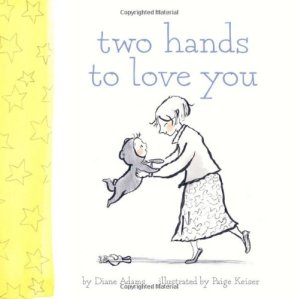 .
.
by Diane Adams & Paige Keiser, illustrator
Chronicle Books 2014
978-0-8118-7797-8
Age 4 to 8 36 pages
.
“With two loving hands, an adoring mother cradles her baby after bath time and a devoted father introduces his toddler to the wonders of he world. Sister, brother, grandma, and grandpa all can’t wait to share what they love best about the world with their newest family member. And when it is time to step ot into the world, this caring family is right there alongside. In simple, heartfelt language, this soothing picture book for the very young will tug at the heartstrings and remind us all of the caring hands that helped us along our way.”
Opening
“When the world is a strange place, unfamiliar and new,
my two hands will hold you, will carry you through.”
The Story
In a nutshell, the story is about a couple who begin a family and the paths they take with their children as they grow and become a family of five—plus two involved grandparents. The first baby is gently cared for, everything new for everyone, not just the baby. As he grows, mom plays outside with her toddler, pulling him in a wagon after an afternoon bath in the sun.
Dad takes over, playing airplane with his son, then cradles the new baby and pledges his love. The first-born cares for the second-born, a girl as curious as her brother. Then the third arrives and the three kids guide and love each other.
Grandparents read to their grandson and blow bubbles for this newest child. The joys of childhood and a mother who races to her crying child. This all is part of this family of five, who love each other.
Review
My loyal readers know what I will write in this space and it will not be that I hated this book. The story is composed of fragments of time, caught like photographs. A mother holds her first-born close, never wanting to let go, but she does. With dad, the toddler continues to grow and this happy family of three thrives. Then enters child number two, a girl. It is daddy’s turn to hold the baby close, his little girl. The images that accompany each frame of time softly plays the scene out for us.
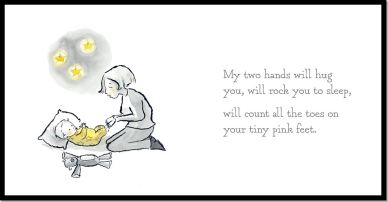
Using watercolors and ink, the artist catches these tender moments, making them precious and tenderer, if that is even possible. Her images could tell this story without the text, which is what a good illustrated picture book should do—words for adults and kids, images for little ones, not yet a reader. I tended to pick up this book and turn its pages carefully, feeling the fragility of family, and the joys of one so close.
Children have real childhoods, playing with each other, guiding each other. Along the way, various hands help the children to grow: mom, dad, grandma and grandpa, and many more not shown.The sweetness is palatable. Two Hands to Love You may well have you thinking about your own little ones, whether they are still little or grown and on their own, maybe starting families. Alternatively, of your own childhood and what that meant to you.
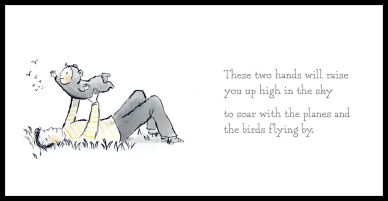
I love the rhyming text. The words fit together perfectly, meaning I did not immediately recognize the rhyme, just the smooth flow of words that belonged together in that precise order. I think this story can help others remember what a family needs to be—a shelter in the storm and a place to learn and grow without ridicule and maybe a little rhyme.
I love the inherent gentleness the illustrations give us. I love the extended family all involved in raising a child. I guess I simply love Two Hands to Love You, which is an ideal baby shower gift. This is also an, “Oh, my, gosh, you’re pregnant” gift. New parents will cherish Two Hands to Love You. It would be the couple’s first, How to Raise Baby book.
For children Two Hands to Love You reinforces that parents will always be there for them, no matter the distance. That home is a shelter from the storm. A place to recharge before heading back into the world. Children want to know their parents will also be there for them. That message rings loudly through the tender pages of Two Hands to Love You.
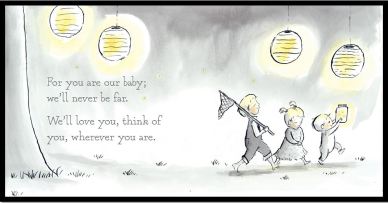
TWO HANDS TO LOVE YOU. Text copyright © 2014 by Diane Adams. Illustrations copyright © 2014 by Paige Keiser. Reproduce by permission of the publisher, Chronicle Books, San Francisco, CA.
To learn more about Two Hands to Love You, click HERE.
Make Two Hands to Love You yours by going to Amazon—B&N—Chronicle Books—or your local bookstore.
Meet the author, Diane Adams at her website: http://www.dianeadams.net/
Meet the illustrator, Paige Keiser at her website: http://www.paigekeiser.com/
Find other incredible books at the Chronicle Books website: http://www.chroniclebooks.com/
.
Also by Paige Keiser
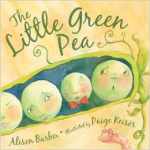
The Little Green Pea
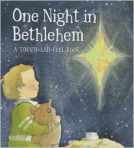
One Night In Bethlehem
.
.
.
. I Love My Hat (October 2014)
.
NEW from Chronicle Books
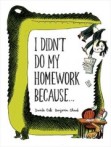
I Didn’t Do My Homework Because . . .
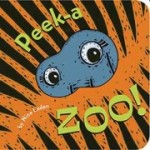
Peek-a Zoo
.
.
.
.
.
.
.

.
Today is National Library Workers Day
Be extras nice to those who staff your library!
Filed under: 5stars, Children's Books, Debut Author, Favorites, Library Donated Books, Picture Book Tagged: children, children's book reviews, Chronicle Books, Diane Adams, family, family relationships, grandparents, growing up, Paige Keiser, parents, raising children
Blog: Kid Lit Reviews (Login to Add to MyJacketFlap)
JacketFlap tags: Middle Grade, teen pregnancy, runaways, family relationships, middle child, 4stars, Library Donated Books, discord, family disfunction, teen marriage, Add a tag
4 stars Shut Up Anne Tibbets Premier Digital Publishing 978-1-9379-5736-0 No. of Pgs.: 110 Ages: 9 to 13* ..................................
Back Cover: Mary’s older sister, Gwen, has royally screwed up her life. Not only is Gwen pregnant at seventeen, she’s also decided to marry The Creep who knocked her up. Now Mary is powerless to stop her family from imploding. Her parents are freaking out royally, and to top it off The Creep has a gross fascination with Mary while Gwen enjoys teasing her for sport.
Despite her brother’s advice to shut up, Mary can’t keep her trapped closed and manages to piss off Mom so much it comes to blows. Mary doesn’t know what to do, and all her attempts to get help are rejected. When she finally plans her escape, she fails to consider how it could destroy them all.
Twelve-year-old Mary is the classic middle child. She tends to blend in and receives too little positive attention. Her older sister is nasty to the entire family, but more so toward Mary, who she seems to enjoy teasing. When Gwen becomes pregnant, losing her friends and status during her senior year, her behavior intensifies. Marrying a guy who is a loser and treats her badly, gropes after her younger sister, and disrespects her parents as much as she does, has not helped anyone. The entire family becomes singularly focused on Gwen’s situation, Gwen’s behavior, Gwen’s tantrums.
Mary and her brother Paul, are the only two with a somewhat clear picture of the family dynamics. Nonetheless, no one listens to anything Mary has to say about anything, let alone about Gwen, The Creep, or any problem they cause. Instead, her words tend to get her into trouble, many times inappropriately so. Mom has lost her grip on the family. She cannot handle Gwen so she seems to take it out on Mary, who is defenseless. Mom is one Gwen-moment away from a nervous breakdown. She is not handling anything correctly, mostly to the detriment of her middle child—Mary.
Shut Up is supposed to be about Mary and her efforts to save her family, but the main character is either Gwen or the family as a whole. I do not see that as a problem for the story, but it is a problem for the intended reader: the middle grades*, kids ages eight to thirteen. Shut Up is a difficult story to read. It is an honest portrait of how one person can run amok, causing all sorts of trouble for the other members of the family, who are often ill equipped to handle such extreme behaviors. I would not let my middle grade child read this until they were a senior in high school. Shut Up is emotionally draining, with minimal respites from all the problems and horrible behavior.
This is simply a difficult book to read and I cannot see many middle grade kids enjoying this, much less being ready to read it. None of the subject matter will be unfamiliar to kids, but the constant barrage of negatives is depressing. The main character, Mary, is more of a punching bag not only for her sister Gwen but for Mom as well. Mom tends to blame Mary even when she is blameless. Her punishments are excessive and often mean spirited.
Having said all this, I did enjoy Shut Up. Any adult interested in family dynamics and how they can be disruptive to the point of destruction, should read this story. The author does not intensify the drama gratuitously. She has written a gut-wrenchingly real story. So much so, that I wonder whose story Shut Up really is—Mary’s or someone real. To be able to write something so authentic without some kind of personal experience would be difficult. Difficult is the operative word. I think Shut Up is something most middle graders are not ready to read. The subject matter is intense, unrelenting, and depressing.
Read an Except HERE.
……………………………….
 Shut Up
Shut Up
Author: Anne Tibbets website Publisher: Premier Digital Publishing website Release Date: February 28, 2012 ISBN: 978-1-9379-5736-0 Number of Pages: 110 Ages: intended for 8 to 13* GoodReads lists as young adult
Filed under: 4stars, Library Donated Books, Middle Grade Tagged: discord, family disfunction, family relationships, middle child, runaways, teen marriage, teen pregnancy
Blog: Writing for Children with Karen Cioffi (Login to Add to MyJacketFlap)
JacketFlap tags: mothers, family relationships, Susan Abel Lieberman, nonfiction family matters, nonfiction book review, family dynamics, mother-in-laws, Add a tag
This Summer Friday Book Review is another doosy. If you think raising your children is a tough job, and that it's over once they're married . . . LOL
Title: The Mother-in-Law’s Manual: Proven Strategies for Creating Healthy Relationships with Married Children
Author: Susan Abel Lieberman, PH.D.
Genre: Nonfiction/Family Matters
Publisher: bright sky press
ISBN: 978-1933979410
The Mother-in-Law’s Manual is a wonderfully insightful and at times humorous advice manual for dealing with not only in-laws, but also other family members. Having recently seen a commercial for Monsters-in-Law, with Jennifer Lopez, it was refreshing to read a much more realistic portrayal of mother-in-laws, especially since I am one myself.
Lieberman’s first chapter explains that when our children are young we are afforded an abundance of advice from professionals such as Dr. Spock. But, when our children are grown, leave the nest and marry, we are left to fend for ourselves. Lieberman’s analogy for the marriage is: “They are moving to a new country that they will create together. Yes, we get territorial. Use my bill of rights. Celebrate my holidays. Serve my food. Even if we don’t see it like a competition, we are likely to consider each deviation a loss.”
Situations that never existed before are now ones that can cause hurt, sadness, and even anger, along with satisfaction and happiness. This book delves into all the emotions that come into play. The child who was once yours now belongs to someone else. The author alludes to the fact that this is more of an issue when it is your son and you are dealing with a daughter-in-law. But, whether son or daughter, the dynamics of the family change.
The Mother-in-Law’s Manual is jammed packed with bits and pieces of wisdom. One of my favorite gems comes right after the “10 most recommended rules” for mothers-in-law which are all the same, “Keep your mouth shut.” Lieberman cleverly explains: “Even if we could follow the rule(s) and not say one word that would be heard as contentious, judgmental, argumentative, or critical […] our children would still hear contentions, judgments, arguments, and criticisms.” As a mother and mother-in-law, these are words that ring true. At times it seems you just can’t win. I thought this section was so funny, I had to read it to my husband.
It is difficult to do justice to all the pearls of wisdom in this book. It explains not to fret over the small things, our perceptions and our intent matter, when not to offer advice, and so much more. It even considers the roles of grandparents, children’s relationships to aging parents, and the aging process itself as Lieberman coins as “zippy to droopy.” She even includes a glimpse of her relationship with her own mother, the frustrations and sometimes guilt that is inevitable when a parent reaches an old age or is ill. Having taken care of a quadriplegic mother my experiences are somewhat different, but in some aspects they are the same. When watching your parent age, you wonder if you’re looking at your future.
Lieberman’s efforts produced an impressive book that all family members should read. Her research involved interviews with as many mothers-in-law across the country and from different backgrounds as she could. She even interviewed a number of daughters-in-law and sons-in-law. Many of these interviews are in the book. Some of their stories/advice sounded familiar, others were surprising. But, they all brought another element of enlightenment. Adult children who read this, married or unmarried, will hopefully gain insight into their parents as not only Mom or Dad, but as individuals with a life of their own including hopes, needs and feelings.
One final gem from the book that struck a chord with me is in Chapter Ten: “I understand my children are not my friends, that our relationship is that unique connection between parent and child. But, there is a way in which we are candid and honest with close, old friends, yet show a carefulness, a respectfulness that can be forgotten with parents. As soon as we begin to feel superior to a friend, the nature of the friendship shifts.” Lieberman hit just about every nail on the head with The Mother-in-Law’s Manual. I give this book 5 Stars and highly recommend it.
About the author: Susan Abel Lieberman currently lives in Houston and works as an executive coach. She has written five books, including New Traditions: Redefining Celebrations for Today’s Family. The Mother-in-Law’s Manual springs from the realization that her assumption that anyone would be thrilled to have her for a mother-in-law was off base. Rather than accepting family tension, she put her skills as a researcher and an executive coach to work to improve the situation. Ordained as an interfaith minister, Lieberman also holds a master’s from Berkeley, and a Ph.D. from the University of Pittsburg. As a wife, mother, mother-in-law and grandmother, she is well-versed in the challenges presented by every stage of family life. The Mother-in-Law’s Manual brings her personal and professional insights together to help mothers-in-law everywhere start a new chapter in their family life.
~~~~~~~~~~
More Reviews
Horatio Humble Beats the Big D
Review of When Teachers Talk
~~~~~~~~~~
To keep up with writing and marketing information, along with Free webinars - signup for The Writing World newsletter on the right top sidebar!
Karen Cioffi
Multi-award Winning Author, Freelance/Ghostwriter, Editor, Marketer
Writer’s Digest Website of the Week, June 25, 2012
Find Karen’s eBooks on writing and marketing at:
http://karencioffifreelancewriter.com (see the sidebar for titles)
Karen Cioffi Professional Writing Services
http://karencioffifreelancewriter.com/karen-cioffi-writing-services/
Blog: Kid Lit Reviews (Login to Add to MyJacketFlap)
JacketFlap tags: best friends, fishing, golf, Loch Ness Monster, new friends, family relationships, sea monsters, job loss, 4stars, first crush, summer vacations, Middle Grade, Add a tag
4 stars Elliot Stone’s summer is ruined! Not only will he be away from his best friend Jake, but he’ll have to miss Cassie’s graduation party of the century while he spends an entire month in a Vermont cabin on Lake Bomoseen. After Elliot’s dad shares the legend of the Loch Ness Monster, a month [...]![]()
View Next 2 Posts







